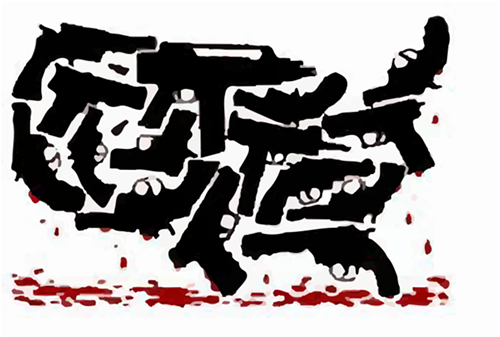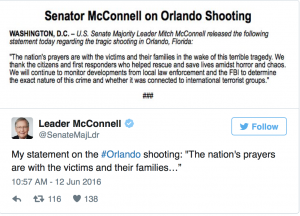By Sandro Galea and Michael Siegel
The Conversation
(Editor’s Note: The following piece was obviously written before the shooting and killing of 5 Dallas police officers on July 7, 2016. In light of the ongoing gun violence in the United States, this piece is more relevant than ever and deserves urgent address.)
After the most recent mass shooting in the U.S. at the Pulse nightclub in Orlando, Senate Majority Leader Mitch McConnell said:
Other politicians echoed that sentiment. But prayers are not going to fix the fact that each year 30,000 deaths and many more injuries are caused by firearm violence. Recognizing gun violence for the public health problem it is might.
So what does it mean to view firearm violence as a public health problem? And how does that change the debate Americans are having about gun violence?
A public health perspective on firearms
First, and most importantly, viewing firearms violence as a public health problem means declaring that the current situation is unacceptable, and preventable.
We did not successfully tackle the AIDS epidemic until we made it a national health priority, an act marked by the passage of the Ryan White Care Act in 1990. Today this position is reflected by the federal government’s commitment to ensure that at least 90 percent of HIV-infected individuals in the U.S. are properly treated by 2020. Federal funding has increased over the course of the epidemic, and the government is spending US$28 billion on domestic HIV prevention and treatment programs during the current fiscal year.
Second, treating firearm violence as a public health problem also means conducting research to identify the underlying causes of the problem and to evaluate potential strategies to address it. For instance, research may reveal common sense structural changes – such as firearm safety features – that limit the potential damage that can be done by guns.
The Centers for Disease Control and Prevention has avoided conducting research on firearm violence since 1996, when Congress passed an appropriations bill barring the CDC from using funds to advocate or promote gun control.
In 2012 President Obama ordered the CDC and other federal bodies to resume research on firearms violence in the wake of the Sandy Hook shooting. But Congress has yet to allocate a single dollar for CDC research on firearm violence.
While the the National Institutes of Health is undertaking firearms research, very little funding is allocated for it, on the order of just $2 million over three years. That’s not much out of the NIH’s nearly $32 billion budget for fiscal year 2016.
Third, a public health perspective on firearm violence means moving beyond blaming individuals and toward societal programs and policies to curb this epidemic. Just as individual smokers are not to blame for the tobacco epidemic, individual gun owners are not to blame for what is a much larger societal problem.
Taking a broad, societal approach is exactly what we have done with other public health problems, such as smoking. Public health research helped identify a proven set of programs and policies that denormalized smoking, such as limitations on smoking in public places and anti-smoking media campaigns. Thanks in large part to these societal-level public health interventions, cigarette smoking prevalence dropped to its lowest level in history last year.
And fourth, a public health approach means the “public” is included in the discussion. This means that we need to listen to concerns across sectors, including gun owners, gun dealers, law enforcement officials and public health advocates. With a public health problem of this magnitude, everyone should be at the table. That might seem impossible now, given the deep polarization on both sides of the gun control debate. However, a lack of willingness to even discuss potential solutions to the problem is simply unacceptable.
A recent collaboration between the public health community and gun dealers to reduce firearms-related suicide in New Hampshire offers an example of what this might look like.

So what does that kind of research look like?
In 2013, Boston University’s School of Public Health started to conduct research aimed at understanding social norms about firearms and gun culture. We have also created a dedicated Violence Prevention Research Unit. So what have we found so far?
In a 2013 study, we linked state homicide data from the CDC with data on gun ownership, which revealed a strong relationship between levels of household gun ownership and firearm-related homicide rates at the state level. We found that this relationship is specific to homicides committed by offenders who are known to the victim.
Earlier this year, we published a study that documented a strong link between gun ownership levels and firearm-related suicide rates. These findings suggest that responding to mass shootings by arming teachers and ordinary civilians is not only unlikely to reduce homicide rates, but the resulting increase in the prevalence of firearms might actually increase deaths from both homicide and suicide.
We have also found a strong relationship between the implementation of state laws that require universal background checks for all gun sales and lower rates of firearm-related homicide.
These findings suggest that the loophole in federal law that allows unlicensed dealers to sell guns to any individual without conducting a background check may be contributing toward higher rates of firearm violence. On June 20, the Senate blocked four gun control measures, including a measure to close the loophole for background checks.
Where our research is headed
Our future work will explore the impact of various state firearm policies and identify policies that are specifically effective in reducing urban violence, which disproportionately impacts the African-American community.
Even though much of this work has been done without external funding, it is essential that Congress allow the CDC to do its job and conduct research on gun violence, and that other federal agencies like the NIH increase allocations for research in this area.
Allocating $0 for research, as CDC currently does on a problem that results in more than 30,000 deaths each year, is not how we handle a public health issue.
Sandro Galea is Dean of the School of Public Health at Boston University. Michael Siegel is Professor of Community Health Sciences at Boston University.
This article was originally published on The Conversation.




